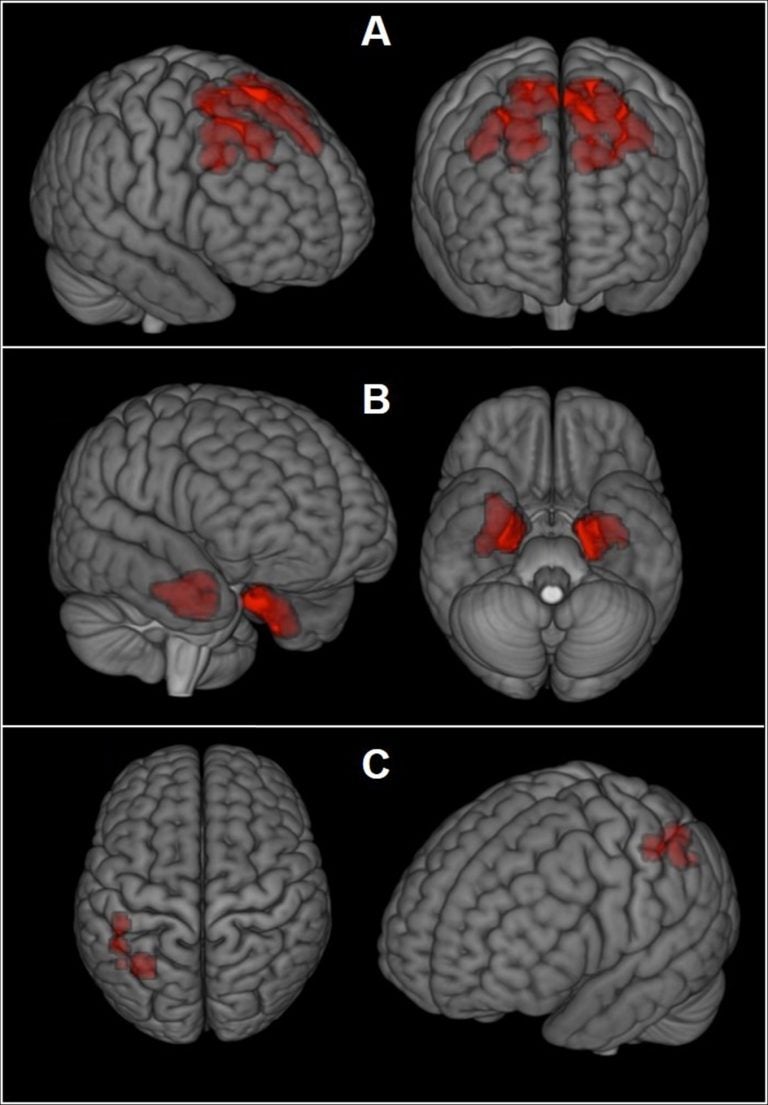Brain scans may reveal concussion damage in living athletes
Researchers may be closing in on a way to check athletes while they're alive for signs of a degenerative brain disease that's been linked to frequent head blows.

This image provided by The New England Journal of Medicine in April 2019 shows an illustration based on brain scans from former NFL players. As a group, they were found to have higher levels of an abnormal protein than a comparison group of healthy men, indicated by red patches. The protein is a hallmark of a degenerative brain disease that's been linked to repeated head blows. (The New England Journal of Medicine via AP)
Researchers may be closing in on a way to check athletes while they’re alive for signs of a degenerative brain disease that’s been linked to frequent head blows. Experimental scans found higher levels of an abnormal protein tied to the disease in a study of former National Football League players who were having mood and thinking problems.
It’s the first time a major study has tested these scans for detecting chronic traumatic encephalopathy, or CTE, which is only diagnosed now after death, with brain autopsies.
Doctors are searching for a way to tell when players, veterans or others with concussions or other head injuries are at risk for permanent damage. It’s too soon to know if the scans will enable that — so far they only show that these athletes are different as a group; they can’t be used to say a particular player does or does not have CTE.
“We’re not there yet,” said Boston University neuroscientist Robert Stern. “It is not ready to be used for individual diagnosis in the clinic.”
He led the study, published Wednesday by the New England Journal of Medicine.
“It’s an encouraging advance. It looks like they have detected CTE in living players,” said Dr. Gil Rabinovici, a neurologist and imaging expert at the University of California, San Francisco, who is doing other research using the scans.
“It’s hugely important to be able to detect the disease in living people” to know how common it is and to research treatments, he said.
The study was done in Massachusetts and Arizona and involved 26 former NFL players with thinking, mood or behavior problems, and 31 similarly aged men without these symptoms or head injuries.
They were given positron emission tomography, or PET scans, in which a radioactive tracer is injected that binds to various substances and makes them visible on the scans. Several of these tracers are used now to look for a protein called beta-amyloid in the brains of people with Alzheimer’s disease. An experimental tracer that doctors are testing binds to another protein, tau, which is the key one that’s been implicated in CTE.
Men in the study had both types of tracers. Tau levels were higher in the players compared to the others, but their amyloid levels were similar, confirming that CTE is a different disease than Alzheimer’s.
Researchers also saw a relationship with years of play.
“The more years of play in tackle football across all levels, the greater the amount of tau detected,” Stern said.
However, there was no relationship between tau levels and the severity of mood and thinking symptoms. Researchers think the study may have been too small to detect a difference or that tau may not be the only factor involved.
“There’s a lot more work to be done to develop a diagnostic” tool using these scans, said Dr. Michael Weiner an imaging expert at UCSF who is involved in other CTE research.
Government grants and Avid Radiopharmaceuticals, which makes the tracers, funded the study. Some authors work or consult for the company.
A larger study of former NFL and college football players is underway; first results are expected early next year.
Mike Adamle, a former running back for the Chicago Bears and sports announcer, has been told he has symptoms consistent with CTE and has been evaluated by Stern at the Boston research center though he was not part of the current study.
“I had more than a few” concussions, Adamle said. “If you were running, everybody kind of led with their head. Back then, it was a test of your macho man stuff.”
The illness has been devastating, said his wife, Kim. “He couldn’t remember his lunch or he couldn’t remember his lines on the air,” and lost multiple jobs, she said.
If a test could have shown he was at risk and given him a chance to consider quitting play, “I would have definitely taken note,” Mike Adamle said.
WHYY is your source for fact-based, in-depth journalism and information. As a nonprofit organization, we rely on financial support from readers like you. Please give today.




